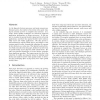Free Online Productivity Tools
i2Speak
i2Symbol
i2OCR
iTex2Img
iWeb2Print
iWeb2Shot
i2Type
iPdf2Split
iPdf2Merge
i2Bopomofo
i2Arabic
i2Style
i2Image
i2PDF
iLatex2Rtf
Sci2ools
MICRO
1997
IEEE
1997
IEEE
Run-Time Spatial Locality Detection and Optimization
As the disparity between processor and main memory performance grows, the number of execution cycles spent waiting for memory accesses to complete also increases. As a result, latency hiding techniques are critical for improved application performance on future processors. In this paper we examine the spatial locality characteristics of several applications, and show that spatial locality varies substantially across and within applications. We then present a microarchitecture scheme which detects and adapts to this varying spatial locality, dynamically adjusting the amount of data fetched on a cache miss. The Spatial Locality Detection Table, introduced in this paper, facilitates the detection of spatial locality across adjacent small cached blocks. Results from detailed simulations of several integer programs show signi cant speedups. The improvements are due to the reduction of con ict and capacity misses by utilizing small blocks and small fetch sizes when spatial locality is absen...
Hardware | MICRO 1997 | Spatial Locality | Spatial Locality Characteristics | Spatial Locality Varies |
| Added | 06 Aug 2010 |
| Updated | 06 Aug 2010 |
| Type | Conference |
| Year | 1997 |
| Where | MICRO |
| Authors | Teresa L. Johnson, Matthew C. Merten, Wen-mei W. Hwu |
Comments (0)

